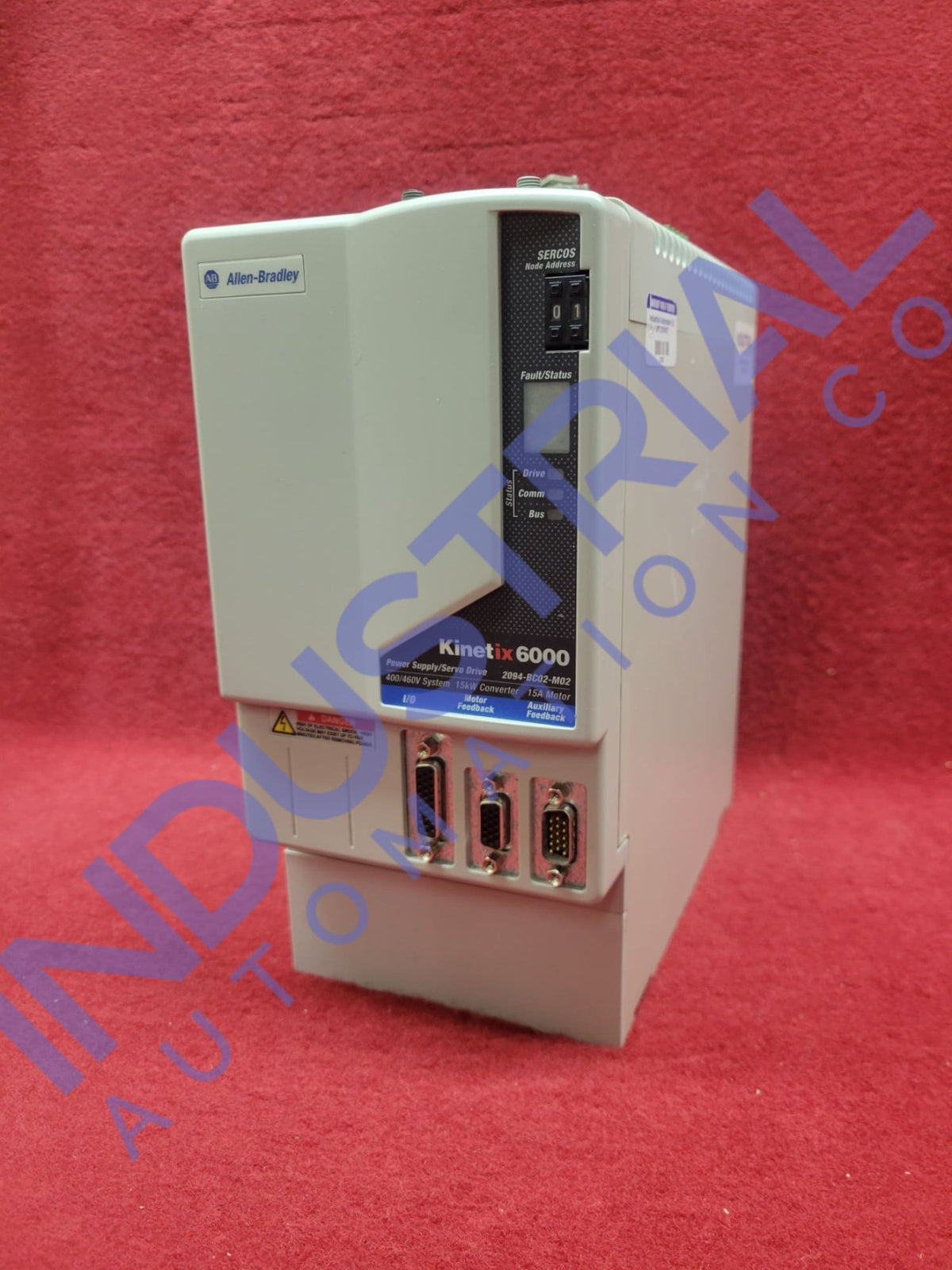Allen-Bradley 2094-BC02-M02 Industrial Automation Co.
$ 2.990,00 $ 747,50
Allen Bradley 2094-BC02-M02
The Allen Bradley 2094-BC02-M02, part of the Kinetix 6000 range, presents a robust solution for servo drive applications. It aims to deliver integrated axis control solutions for various drive, motor, and actuator applications. With a focus on performance and versatility, these drives offer a comprehensive solution for motion control needs across industries.
Technical Specifications:
Designed for 400/460V systems with a 15kW converter and 15A inverter, it offers reliability and power for various industrial settings.
The nominal peak current capacities are preset at 150% of the permanent current, with the flexibility to program modules for up to 250% of the permanent inverter current, offering adaptability to diverse operational demands.
In terms of physical dimensions, the Allen Bradley 2094-BC02-M02 measures 28.7 cm in height, 12.5 cm in width, and 30.2 cm in length.
Operation and Configuration:
Upon installation, the module interfaces with the drive, motor, and actuator components to deliver precise motion control according to the application’s requirements. Power is supplied to the module, activating its integrated circuitry and enabling communication with external devices and the broader control system.
Configuration of the Allen Bradley 2094-BC02-M02 involves setting parameters tailored to the specific needs of the application. Through intuitive programming interfaces, operators can adjust parameters such as speed, torque, and acceleration to achieve optimal performance.
Additionally, advanced features such as peak current enhancement can be programmed to accommodate varying load demands, ensuring smooth operation across a range of conditions.
The module’s compatibility with accessories such as brake resistor modules and power rails further enhances its configurability, allowing for expansion and customization as needed. Interface modules with Sercos interfaces offer flexibility in system design, facilitating seamless integration with other components and communication protocols.
During operation, real-time feedback from sensors and encoders allows the Allen Bradley 2094-BC02-M02 to adjust parameters dynamically, ensuring precise motion control and response to changing conditions. This closed-loop control mechanism enhances accuracy and stability, even in complex motion profiles or high-speed applications.
Maintenance and Troubleshooting:
Regular inspections should be conducted to check for signs of wear, damage, or loose connections. Cleaning the module and its surrounding area to remove dust and debris can prevent overheating and electrical issues. Ensuring adequate ventilation and cooling is crucial to maintaining optimal operating temperatures.
Troubleshooting the Allen Bradley 2094-BC02-M02 involves systematic diagnosis of potential issues. If the module fails to operate correctly, begin by verifying the power supply and ensuring all connections are secure. Inspect the module for any visible signs of damage, such as burnt components or discolored areas, which may indicate overheating or electrical faults.
Common troubleshooting steps may include resetting the module, reconfiguring parameters, or replacing faulty components. If the module is part of a larger network, checking the communication integrity between devices can help identify whether the issue is isolated or systemic.
Frequently Asked Questions:
Is there any specific shock and vibration tolerance for the Allen Bradley 2094-BC02-M02?
Allen Bradley 2094-BC02-M02 can withstand a shock acceleration of 15g and a vibration displacement of 0.35mm, ensuring reliable performance in demanding industrial environments.
What is the ambient temperature range for the Allen Bradley 2094-BC02-M02?
The Allen Bradley 2094-BC02-M02 operates effectively within an ambient temperature range of 0°C to 50°C (32°F to 122°F), ensuring reliable performance in various industrial environments.
What communication interface does the Allen Bradley 2094-BC02-M02 use?
The Allen Bradley 2094-BC02-M02 uses a Sercos interface, which facilitates high-speed, synchronized communication with other components in the automation system, ensuring seamless integration and efficient control.
Product Specifications Table
| Condition | IAC Certified Refurbished |
|---|
Fast Shipping & Professional Packing
Because of our long-standing partnership with UPS, FedEx, DHL as well as a range of other top global carriers we can provide a variety of shipping options. Our warehouse staff is highly skilled and will package your items in accordance with our exact and precise specifications. Your items are carefully inspected and securely secured prior to shipment. Every day we ship hundreds of packages to our customers across many countries. This shows our commitment to become the biggest online retailer in the world. Both Europe and the USA have warehouses and distribution centers.
Orders that contain more than one item are given processing time according to each item.
Prior to shipment, we inspect the ordered items thoroughly before sending the items. The majority of orders will be shipped within 48 hours. The delivery time is estimated to be between three and seven days.
Returns
The stock is constantly changing and not fully managed by us due to the involvement of several entities, including the factory as well as our warehouse. The levels of stock can change at any moment. Please be aware that it's possible that your order will become unavailable even after you have placed the order.
Our policy is valid for 30 days. If you don't receive the product within the 30 days period, we are not able to issue a refund or an exchange.
The item you purchase must be in the original packaging and in good condition. It must also not be used. It must also be returned in the original packaging.
Related products
Uncategorized
Uncategorized
Uncategorized
Uncategorized
Uncategorized
Uncategorized
Uncategorized
Uncategorized
Uncategorized
Uncategorized
Uncategorized
Uncategorized
Uncategorized
Uncategorized
Uncategorized
Uncategorized
Uncategorized
Uncategorized
Uncategorized
Uncategorized
Uncategorized
Uncategorized
Uncategorized
Uncategorized
Uncategorized
Uncategorized
Uncategorized
Uncategorized
Uncategorized
Uncategorized
Uncategorized
Uncategorized






































